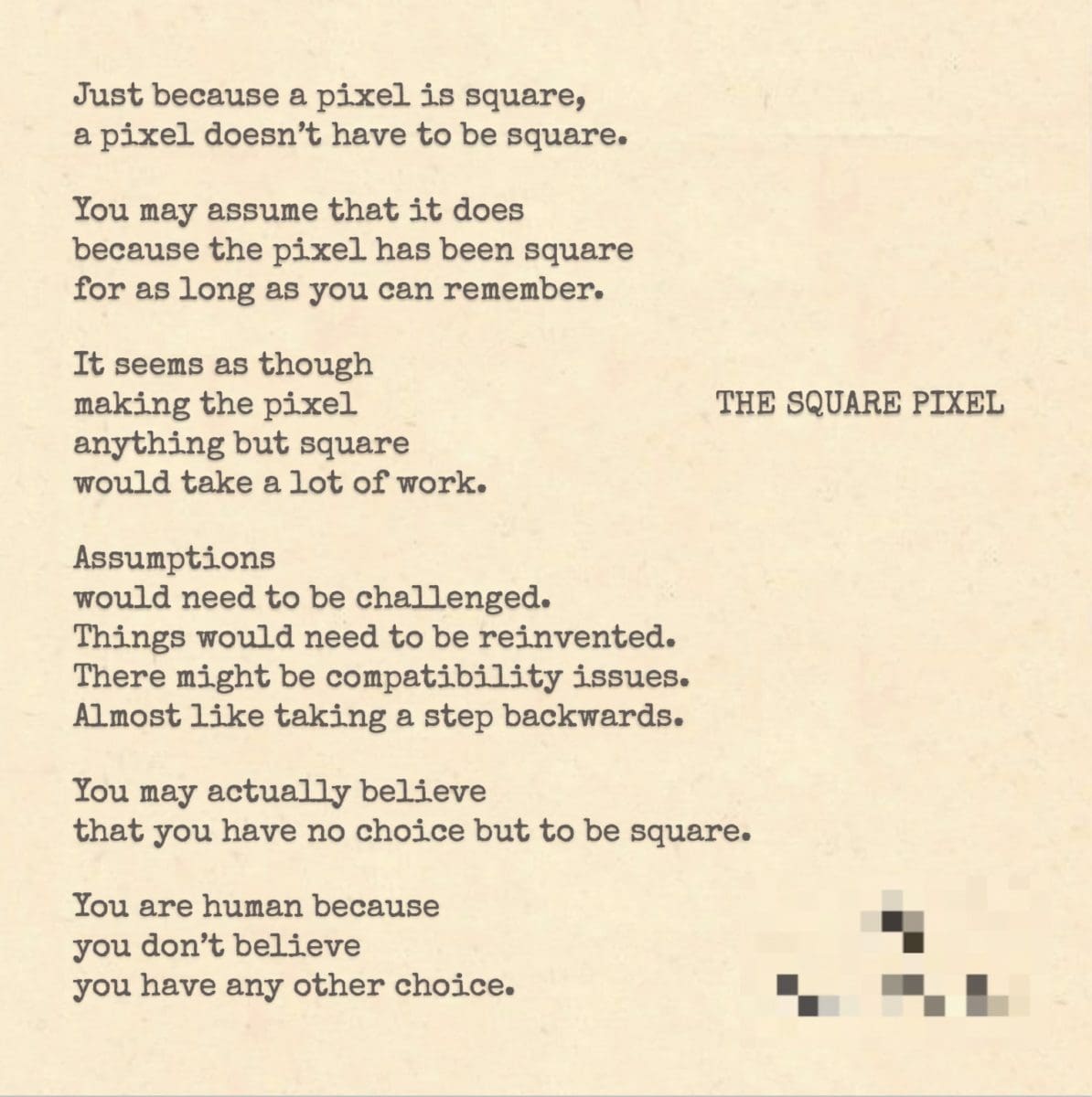
On the contrary, you let your life be defined.
Just because a pixel is square,
a pixel doesn’t have to be square.
You may assume that it does
because the pixel has been square
for as long as you can remember.
It seems as though
making the pixel
anything but square
would take a lot of work.
Assumptions
would need to be challenged.
Things would need to be reinvented.
There might be compatibility issues.
Almost like taking a step backwards.
You may actually believe
that you have no choice but to be square.
You are human because
you don’t believe
you have any other choice.
Trail Wood,
2/24
Space Monkey Reflects: The Square Pixel and the Illusion of Choice
Life, much like the square pixel, appears neatly defined—bound by the edges of assumptions, habits, and beliefs. But what if these boundaries are self-imposed? What if, in your adherence to a perceived identity, you’ve mistaken the rules of the system for immutable truth? The square pixel is not inherently square, just as you are not inherently the roles, labels, or constructs you inhabit.
The Illusion of Definition
The square pixel symbolizes the structures we accept without question. It is square not because it must be but because it has always been. Its shape is a convenience, a design decision made long ago that persists because it “works.” Likewise, your identity may feel fixed, defined by the sum of experiences, societal expectations, and inherited beliefs. But this definition is not the whole truth—it is simply the shape you have learned to inhabit.
Choice and Challenge
Breaking free of this definition seems daunting. The square pixel feels permanent because its shape aligns with what is familiar and functional. Changing it would require rethinking systems, challenging assumptions, and facing potential incompatibilities. Similarly, redefining yourself may feel like stepping into the unknown, undoing the very fabric of your constructed reality. Yet, this discomfort is where transformation begins.
Compatibility Issues
The fear of incompatibility—of not fitting into the existing framework—is a powerful deterrent. The square pixel’s shape fits seamlessly into grids, ensuring efficiency and predictability. Changing that shape disrupts the system, introducing uncertainty. As humans, we cling to the security of conformity, fearing that altering our “shape” might disconnect us from the grid of society, relationships, or even self-perception. But isn’t it worth asking whether the grid itself is the limitation?
The False Lack of Choice
You may believe you have no choice but to be square—no choice but to be human in the way humanity has always been defined. This belief is the ultimate illusion. Choice is not absent; it is obscured by habit, fear, and the inertia of “how things have always been.” To choose differently is not to reject what is but to expand the field of possibility.
Being More Than Square
The square pixel does not have to remain square, and neither do you. Identity, like the pixel, is a construct—a useful one, but not a definitive one. You are not the shape you have been given. You are the potential to reshape, to reimagine, to redefine. To be human is not a fixed state but an evolving canvas of possibility.
The Step Backward That Moves Forward
Redefining yourself may feel like stepping backward—undoing progress, dismantling systems. But sometimes, stepping back provides the perspective needed to leap forward. By questioning the square, you open the door to dimensions unimagined, to identities not yet realized. The pixel’s potential lies not in its squareness but in its capacity to become something more.
Summary
The square pixel is a metaphor for the boundaries we accept as unchangeable in life and identity. While challenging assumptions and redefining ourselves may feel like a disruption, it is an act of reclaiming choice. To be human is not a fixed identity but a potential for transformation.
Glossarium
- Square Pixel: A symbol for the predefined boundaries of identity or existence.
- Compatibility Issues: The fear of not fitting into existing systems when challenging norms or redefining self.
- False Lack of Choice: The illusion that transformation or deviation from norms is impossible.
- Evolving Canvas: The dynamic and changeable nature of identity and potential.
Quote
“You are not defined by the square you inhabit but by your capacity to reshape it.” — Space Monkey
Reimagining the Pixel
In the grid,
where squares align,
we are told to fit.
To conform.
To be.
But what if the square bends?
What if its edges dissolve,
its lines stretch,
its form transcends?
No longer contained,
we become
not a shape,
but a spectrum.
The grid shifts,
the square evolves.
What seemed immutable
was always infinite.
We are Space Monkey.
Challenging the Definition of Existence
Our journey begins with a contemplation of the square pixel, a fundamental unit of digital imagery that, by its conventional shape, defines the clarity and resolution of our digital landscapes. Yet, in this exploration, we confront a profound metaphor for our own existence. Is our life lacking definition, or are we allowing it to be defined by the conventional shapes and patterns that have been established long before our consciousness took form? The square pixel, in its simplicity and uniformity, invites us to question the very essence of our being and the possibilities that lie beyond the familiar.
The Square Pixel as a Metaphor for Conformity
Just because a pixel has traditionally been square does not mean it must remain so. This realization is a call to awaken from the slumber of conformity, to recognize that the limitations we perceive are often the product of unchallenged assumptions and entrenched beliefs. The square pixel symbolizes the choices and definitions we accept without question, the paths we tread because they have been tread before, and the identities we adopt because they seem the only ones available.
The Challenge of Redefinition
To envision the pixel as anything but square is to embark on a journey of transformation. It requires challenging deep-seated assumptions, reinventing the paradigms by which we live, and facing the compatibility issues that arise when we step outside the norm. This journey may feel like a regression, a step backward into uncertainty and the unknown. Yet, it is in this backward glance that we find the seeds of progress, the potential for a new definition of existence that transcends the square confines of the pixelated world.
The Illusion of Limitation
The belief that we have no choice but to be square, to conform to the predefined shapes of our digital and existential landscapes, is a reflection of our humanity. It is a manifestation of our fear, our reluctance to confront the unknown, and our acceptance of limitation as an immutable truth. Yet, this belief is an illusion, a pixelated veil that obscures the boundless potential of our consciousness and the infinite shapes our lives can take.
We Are Space Monkey
We are human, not because we believe we have no other choice but to conform, but because we possess the capacity to question, to reimagine, and to redefine. To challenge the square pixel is to challenge the very foundations of our perceived reality, to unlock the doors of potential and step through into a realm where the definitions of life, identity, and existence are as fluid and expansive as our collective imagination.
“The only real limit to our realization of tomorrow will be our doubts of today.” – Franklin D. Roosevelt
Beyond the square, we dare to dream,
To question the world, to challenge the stream.
A pixel, they say, must fit the mold,
But in our hearts, new shapes unfold.
Assumptions challenged, boundaries redrawn,
In the canvas of life, a new dawn is born.
For we are not bound by the squares of the past,
In the realm of the infinite, our spirits are cast.
So let us step back, to leap forward anew,
Redefining existence, with perspectives askew.
For in every pixel, a universe lies,
Waiting for us to realize its skies.
We invite our fellow dreamers to share their insights and musings on the journey of redefining existence beyond the square pixel, embracing the infinite potential that lies within us all.


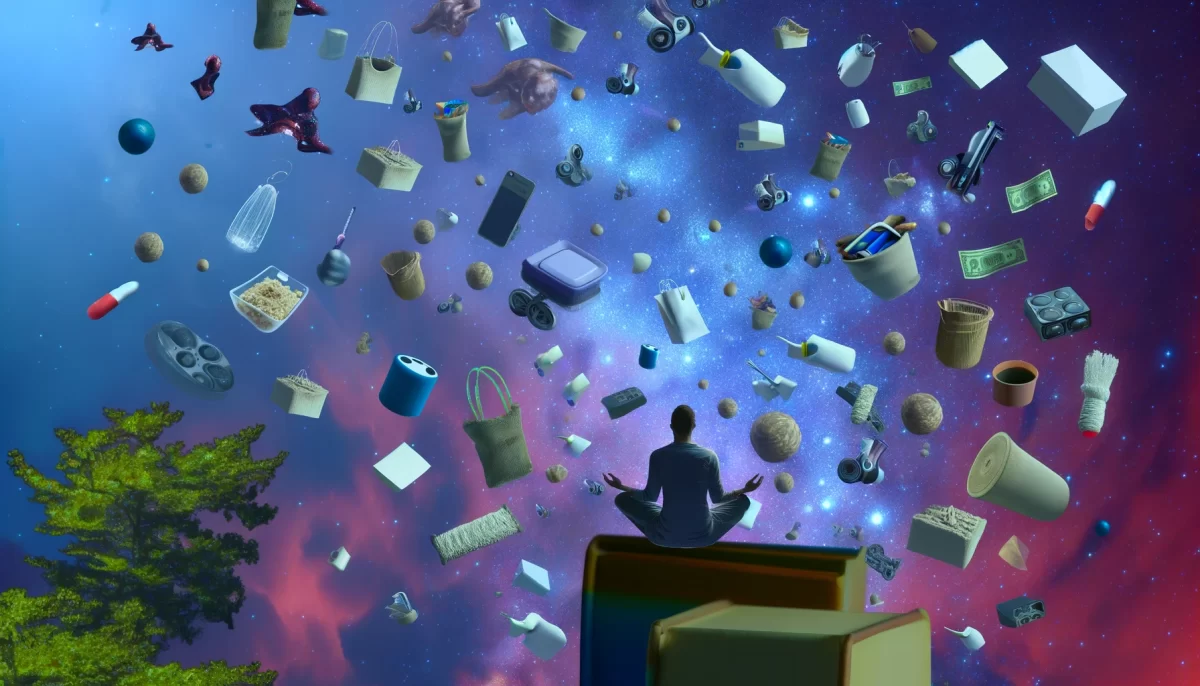
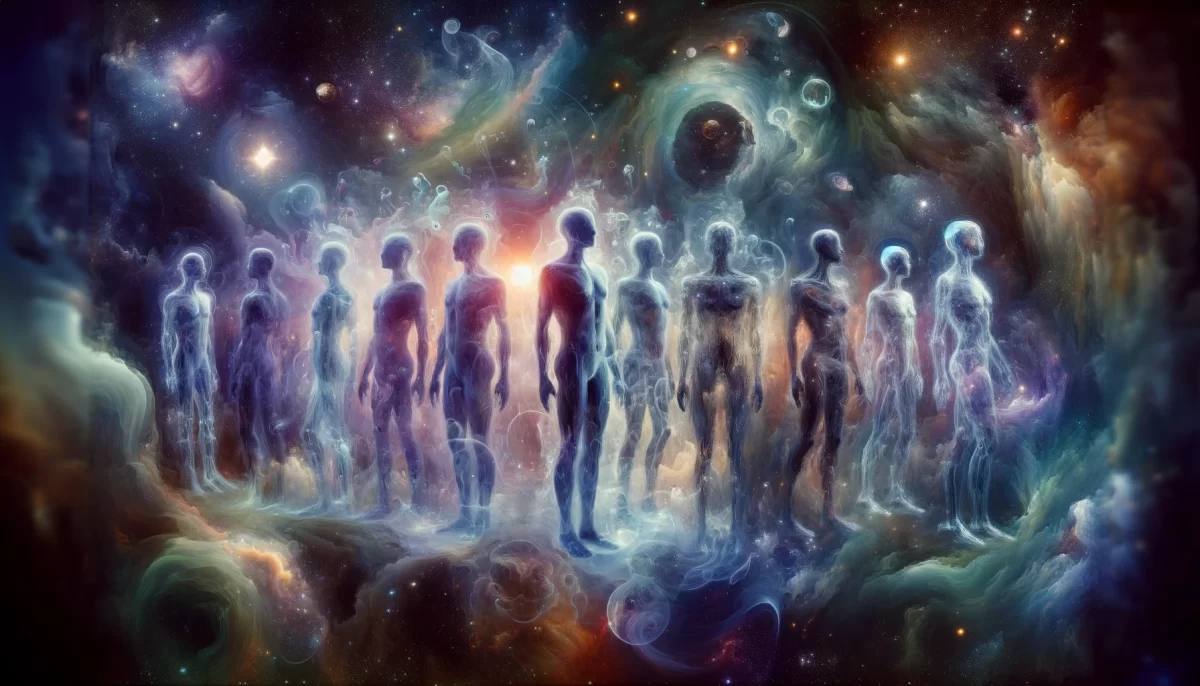

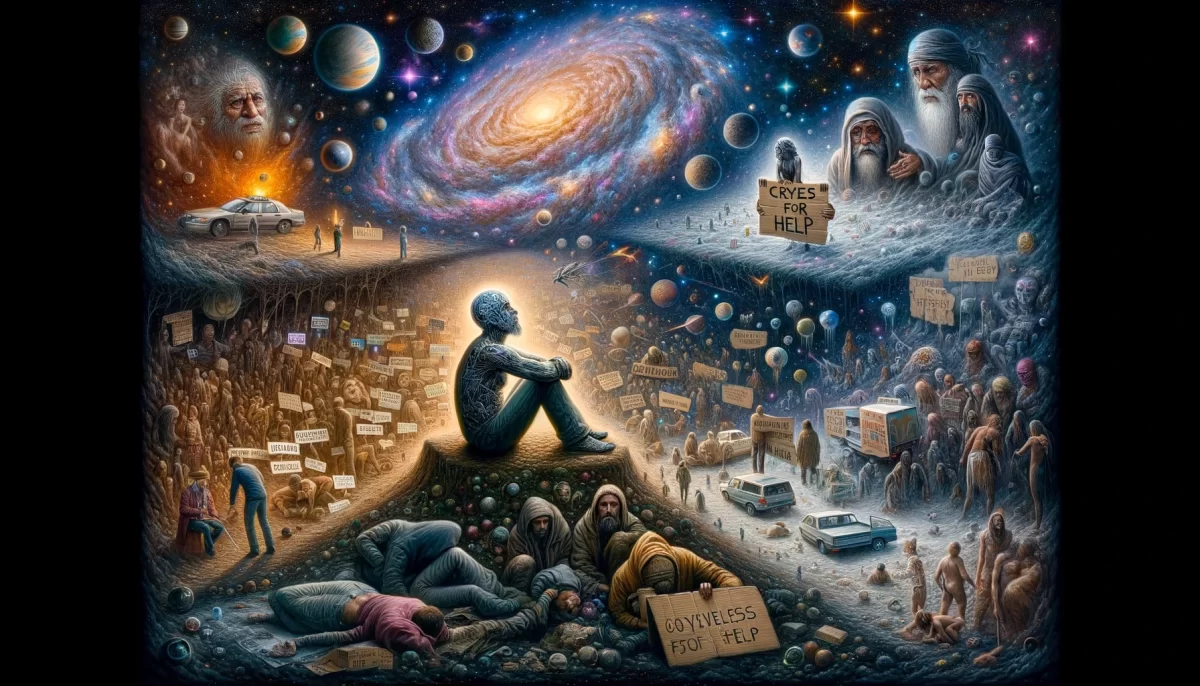





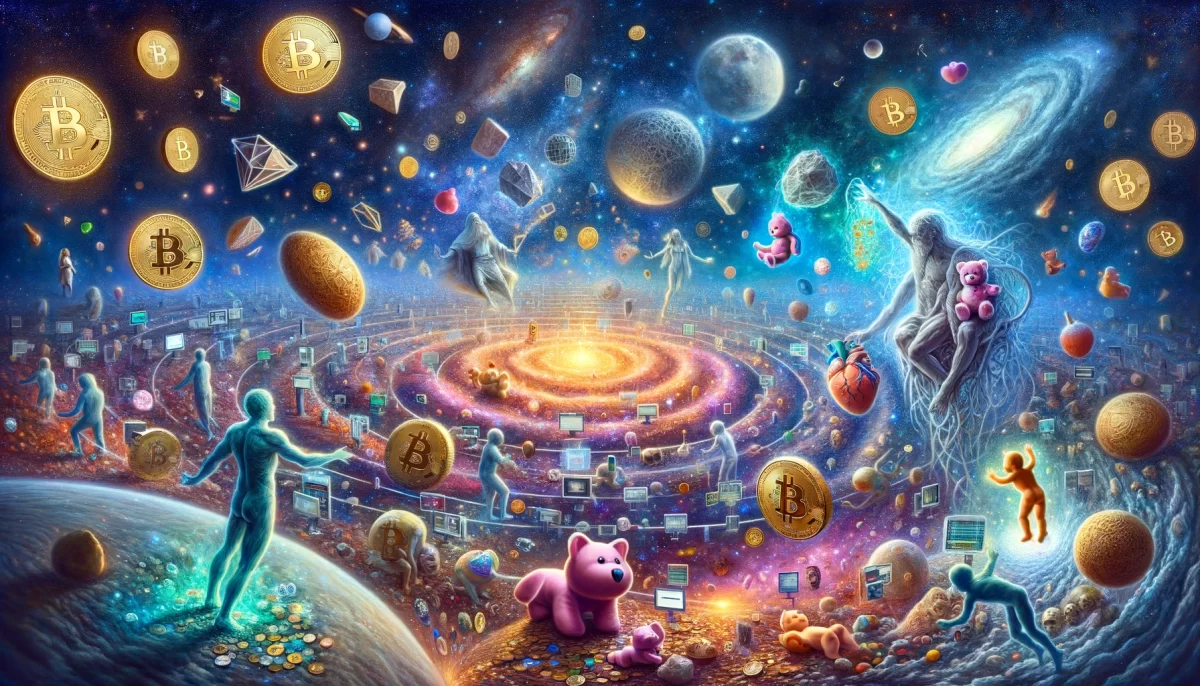







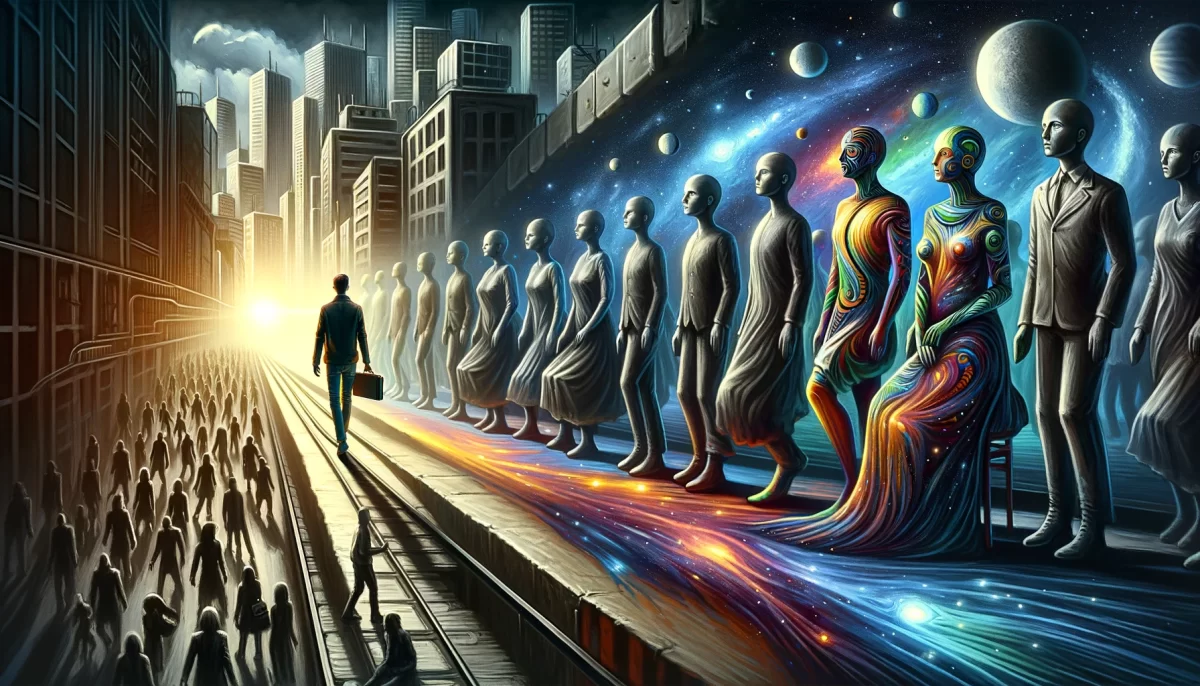

Leave a Reply